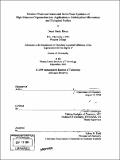Solution-phase and automated solid-phase synthesis of high-mannose oligosaccharides : application to carbohydrate microarrays and biological studies
Author(s)
Ratner, Daniel Martin, 1977-
DownloadFull printable version (11.15Mb)
Other Contributors
Massachusetts Institute of Technology. Dept. of Chemistry.
Advisor
Peter H. Seeberger.
Terms of use
Metadata
Show full item recordAbstract
(cont.) 2G12, cyanovirin-N, and a recently identified anti-HIV protein, scytovirin. Glycosylation is critical to cellular function in eukaryotic systems. N-linked modification of asparagine residues within nascent proteins is involved in numerous folding and processing pathways. N-linked glycans are also a common feature of viral-associated envelope glycoproteins, including gpl20 and gp41 of the human immunodeficiency virus (HIV-1). These glycans are attractive targets for therapy and prophylaxis due to their numerous roles in HIV infectivity and immunoevasion. This thesis describes the solution-phase synthesis of a series high-mannose type glycans using a linear synthetic approach. The synthetic mannans are used to study the potent anti-HIV microbicide cyanovirin-N, a novel 11 kDa protein isolated from the cyanobacterium (blue-green algae) Nostoc ellipsosporum. These studies established the structural basis for carbohydrate-binding by cyanovirin-N, which is responsible for its HIV inactivating properties. Automated solid-phase synthesis and microfluidic reactors were employed in the development of new technologies for synthetic carbohydrate chemistry. Utilizing a carbohydrate synthesizer, the first automated solid-phase synthesis of the N-linked core pentasaccharide is detailed. In addition, the design, fabrication and application of a microreactor for optimizing the glycosylation reaction is described. Utilizing a novel tri(ethylene glycol) linker with a reactive thiol handle, the fabrication of carbohydrate microarrays is depicted. A panel of oligosaccharides was selected to represent the major structural determinants of high-mannose type glycans on a single microarray. These microarrays were used study the glycan-dependent binding interactions of four gpl20-binding proteins: the dendritic cell lectin DC-SIGN, the antibody
Description
Thesis (Ph. D.)--Massachusetts Institute of Technology, Dept. of Chemistry, 2004. Vita. Includes bibliographical references.
Date issued
2004Department
Massachusetts Institute of Technology. Department of ChemistryPublisher
Massachusetts Institute of Technology
Keywords
Chemistry.